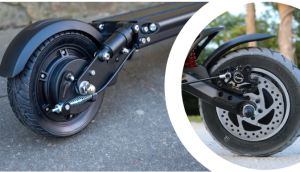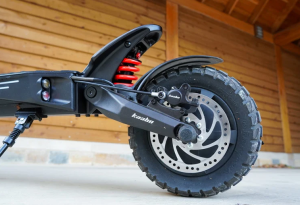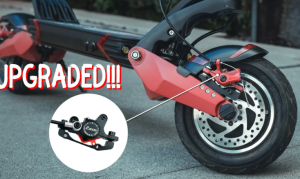Yes, electric scooters have brakes; most models feature either mechanical (disc or drum) or electronic (regenerative) braking systems for safety.
Introduction
Overview of Electric Scooters
Electric scooters have emerged as a pivotal mode of urban transportation, offering a convenient and eco-friendly alternative to traditional vehicles. With electric motors powering them, these scooters are designed for both short and long distances, boasting speeds that can reach up to 25 km/h. The appeal of electric scooters lies in their efficiency and cost-effectiveness, significantly reducing the reliance on fossil fuels and lowering emissions. A standout feature is their portability, with many models being lightweight and foldable, allowing for easy storage and transportation.
Importance of Braking Systems
The braking system is crucial in ensuring the safety of electric scooter riders. Effective brakes not only provide the ability to stop quickly in emergencies but also contribute to the overall control and stability of the scooter during rides. Disc brakes, known for their high performance and reliability, are common in high-end models and can significantly reduce stopping distances. For instance, an electric scooter equipped with disc brakes can come to a complete stop from a speed of 20 km/h in just a few meters, while those with less efficient braking systems might require double that distance.
Types of Braking Systems
Mechanical Brakes: These include disc and drum brakes, which are celebrated for their durability and effectiveness. Disc brakes, in particular, are renowned for their ability to perform under various weather conditions, offering consistent stopping power without significant degradation over time. Drum brakes, on the other hand, provide a more cost-effective solution with decent performance and less maintenance.
Electronic Brakes: Electronic or regenerative braking systems convert the scooter’s kinetic energy back into electrical energy, extending the battery’s life. While not as immediately powerful as mechanical brakes, they offer a unique advantage in efficiency and sustainability, enhancing the scooter’s overall energy usage.
Safety Enhancements
Braking systems directly influence the safety and maneuverability of electric scooters. Advanced braking systems incorporate ABS (Anti-lock Braking System) technology, which prevents the wheels from locking up during an emergency stop, maintaining traction with the road and allowing the rider to maintain control. This technology can be the difference between a safe stop and a potential accident, underlining the importance of high-quality braking systems in electric scooters.
Electric scooters stand out as a key player in urban mobility solutions, driven by their efficiency, convenience, and environmental benefits. The braking system, a critical component for safety, significantly influences the performance and reliability of these vehicles. With advancements in technology, electric scooters continue to evolve, offering safer, more efficient, and more enjoyable rides to users worldwide.
Types of Brakes in Electric Scooters
The braking system in electric scooters is pivotal for ensuring rider safety and vehicle control. There are mainly two categories: Mechanical Brakes and Electronic Brakes, each with their own types and functionalities.
Mechanical Brakes
Disc Brakes and Drum Brakes fall under this category, offering physical means to slow down or stop the scooter through friction.
Disc Brakes: Utilize a metal disc (rotor) attached to the wheel and a caliper that squeezes the disc to create friction and slow the scooter down. They are known for their excellent stopping power and efficiency in wet conditions. Typically, disc brakes can reduce stopping distance by up to 40% compared to drum brakes, making them a preferred choice for high-speed electric scooters.
Drum Brakes: Incorporate a set of brake shoes that press outwards against a rotating drum attached to the wheel. While not as efficient as disc brakes in dissipating heat, drum brakes are more protected from the elements and require less frequent maintenance. They are often found in budget-friendly models due to their lower cost.
Electronic Brakes
This category includes Regenerative Braking Systems and Electric Brake Assist, which use the scooter’s electric motor for braking.
Regenerative Braking System: Converts the scooter’s kinetic energy back into electrical energy, which is then stored in the battery. This system not only helps to slow the scooter down but also extends the battery’s range. The effectiveness of regenerative braking varies, but it can increase the scooter’s range by approximately 5% to 10% under optimal conditions.
Electric Brake Assist: Provides additional braking power through the electric motor, often in conjunction with mechanical brakes. This system can significantly improve the scooter’s stopping power and safety but is more complex and costly to implement.
Here’s a comparison of these braking systems:
| Feature | Disc Brakes | Drum Brakes | Regenerative Braking | Electric Brake Assist |
|---|---|---|---|---|
| Stopping Power | Excellent | Good | Moderate | Good-Excellent |
| Maintenance | Moderate | Low | Low | Moderate |
| Cost | Higher | Lower | Moderate | Higher |
| Efficiency in Wet Conditions | High | Moderate | High | High |
| Complexity | Moderate | Low | High | High |
| Lifespan | Long | Longer | N/A | N/A |
| Suitability | High-speed scooters | Budget-friendly scooters | Eco-conscious riders | Advanced models for enhanced safety |
Disc brakes shine in performance and safety, especially under harsh conditions, while drum brakes offer a cost-effective solution with decent performance and minimal upkeep. Regenerative braking excels in energy efficiency, extending the ride’s range, whereas electric brake assist enhances overall braking responsiveness and safety, albeit at a higher complexity and cost.
How Electric Scooter Brakes Work
The braking system in electric scooters is fundamental to the rider’s safety, offering the ability to decelerate and stop effectively. Understanding the functionality of mechanical and electronic brakes is crucial for choosing the right electric scooter and maintaining it properly.
Functionality of Mechanical Brakes
Mechanical brakes operate through physical mechanisms that apply force to the scooter’s wheel, slowing it down. There are two primary types:
- Disc Brakes: Use calipers to squeeze pairs of pads against a disc or rotor attached to the wheel hub. When the brake lever is pressed, hydraulic fluid or mechanical cables actuate the calipers, creating friction that slows down the scooter. Disc brakes are known for their high performance, offering consistent braking power in various weather conditions and requiring less force to activate. They typically provide a quicker, more controlled stop than drum brakes, making them a popular choice for high-speed electric scooters.
- Drum Brakes: Incorporated within the wheel hub, drum brakes involve brake shoes that press outwards against a rotating drum. Activated by a cable when the brake lever is pressed, they generate friction to decelerate the scooter. Drum brakes are praised for their durability and low maintenance, as the braking mechanism is enclosed, protecting it from dirt and water. They might not offer the same level of performance in stopping power and heat dissipation as disc brakes.
Functionality of Electronic Brakes
Electronic brakes use the scooter’s motor for braking:
- Regenerative Braking System: Converts the scooter’s kinetic energy back into electrical energy, which is then stored in the battery. When the rider activates the brake, the motor’s polarity is reversed, creating resistance that slows down the scooter. This system not only helps in braking but also enhances the battery’s efficiency by recharging it during braking. However, the stopping power provided by regenerative braking alone is often insufficient for immediate stops, making it commonly used in conjunction with mechanical brakes.
- Electric Brake Assist: Works by applying electrical resistance to the motor, slowing down the scooter. This system is simpler and requires no physical contact parts, thus reducing wear and tear. While it offers a smoother braking experience and is maintenance-free, it generally provides less immediate stopping power compared to mechanical brakes.
Both mechanical and electronic braking systems have their advantages and are often found in tandem on electric scooters to provide a balanced, efficient, and safe braking solution. Mechanical brakes excel in their immediate stopping power and control, particularly important at higher speeds or in emergency situations. Electronic brakes, on the other hand, offer an additional layer of energy efficiency and durability, extending the scooter’s range and reducing the need for maintenance. Riders should consider their typical riding conditions, speeds, and personal preferences when evaluating the importance of each braking system type.
Choosing the Right Brake Type for Your Electric Scooter
Choosing the right brake type for your electric scooter is a crucial decision that affects both safety and performance. By considering specific factors and understanding how different brakes cater to various use cases, riders can make informed choices tailored to their needs.
Factors to Consider
When selecting a brake system for an electric scooter, several key factors should be taken into account:
- Riding Environment: Urban riders facing stop-and-go traffic may benefit from disc brakes due to their superior stopping power and quicker response. In contrast, those riding in less crowded areas might find the durability and low maintenance of drum brakes more appealing.
- Rider’s Speed Preferences: High-speed riders need reliable, efficient brakes for safety. Disc brakes offer the best performance in terms of deceleration and control, making them a preferred choice for speed enthusiasts.
- Maintenance Willingness: If you prefer a low-maintenance solution, consider electronic brakes or drum brakes. Electronic brakes require virtually no maintenance, while drum brakes are less exposed to environmental wear and tear compared to disc brakes.
- Budget Constraints: Drum brakes are generally more cost-effective both in upfront costs and maintenance. However, for those prioritizing performance over cost, disc brakes, despite being more expensive, provide value through enhanced safety and efficiency.
- Terrain Types: For hilly terrain, disc brakes or a combination of regenerative and mechanical brakes offer the most control and efficiency, helping to manage descents and improve battery performance through energy recovery.


